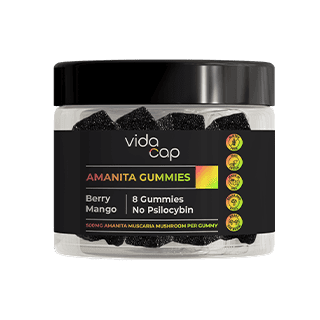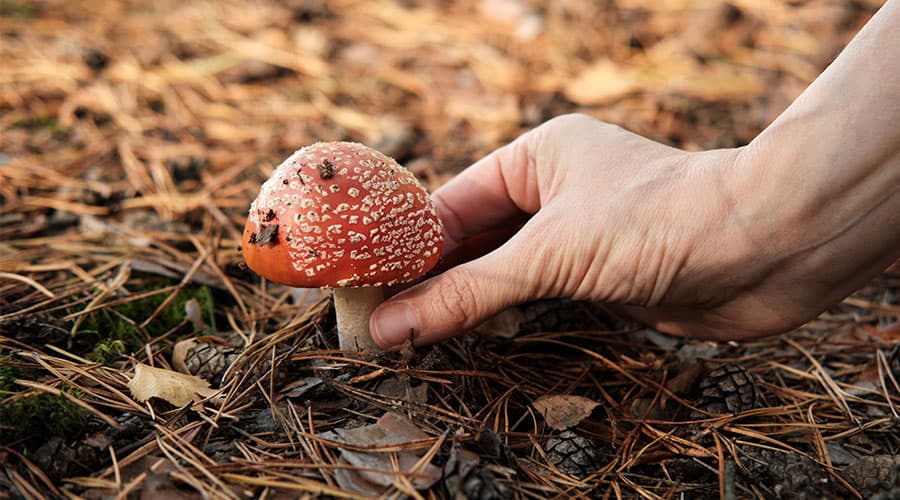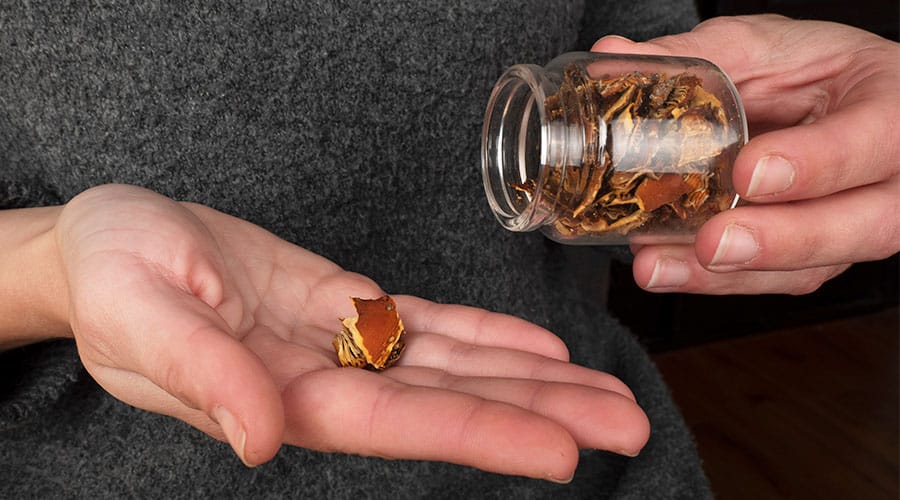If you’ve spent any time researching Amanita muscaria, chances are, you’ve read that it is a poisonous mushroom. Certainly, eating freshly picked amanita that hasn’t gone through the right processing is unwise.
However, as amanita experts know, once you prepare this magnificent mushroom correctly, the dangers of toxicity are replaced by a host of benefits.
The key is amanita decarboxylation, also known as “decarbing.” It involves removing a carboxyl group (COOH) from specific compounds in the mushroom.
Ibotenic acid and muscimol are the most relevant compounds in amanita. Decarbing this mushroom involves converting ibotenic acid into muscimol.
This article explains what decarbing means, provides a simple step-by-step guide to completing the process, and highlights why proper decarboxylation is essential to get the best out of the Amanita muscaria mushroom.

If you’re unable or unwilling to decarb amanita mushrooms yourself, you don’t have to miss out. VidaCap’s amanita gummies contain 500mg of extract apiece, including a high level of muscimol. The brand expertly decarboxylates its mushrooms, leaving behind a premium-grade product. Rather than waiting hours to sample amanita, pop a gummy in your mouth and wait for the effects.
What Is Decarboxylation?
Despite the complex name, decarboxylation is a simple chemical reaction that removes a carboxyl group in a chemical structure, releasing it as carbon dioxide. In essence, it means removing two groups connected to a carbon.
As far as amanita mushrooms are concerned, removing a carboxyl group converts ibotenic acid into muscimol. This is important because ibotenic acid is believed to have neurotoxic effects. In contrast, muscimol is linked to more beneficial outcomes. Thus, it is desirable to have amanita products with high levels of muscimol and low amounts of ibotenic acid.

Ibotenic acid’s chemical formula is C5H6N2O4. In contrast, muscimol’s is C4H6N2O2. Those with chemistry knowledge will see that ibotenic acid has one more carbon atom and two more oxygen atoms than muscimol.
Remember that the decarbing process releases CO2, which consists of two oxygen atoms and a carbon atom. Therefore, it is the ideal way to eliminate ibotenic acid from amanita and convert it into muscimol. Decarbing turns Amanita muscaria from a substance to avoid into something worth trying.
We discuss the benefits of muscimol and the necessity of removing ibotenic acid from amanita later. First, though, let’s outline how to decarboxylate this unique mushroom.
How to Decarb Amanita Mushrooms
There’s a significant debate regarding what percentage of muscimol should be in amanita when you consume it. We’ll explore this issue towards the end of this article.
However, the following decarbing method removes as much ibotenic acid as possible, otherwise known as complete decarboxylation. Those who have tried it are often surprised by how straightforward it is.
You can use heat, acid, pressure, or a combination of all three. You can also use lactobacillus, a strain of bacteria featuring an enzyme that breaks the molecule down.
In any case, you’ll need the following equipment to get started:
- Amanita mushrooms
- Distilled water and tap water
- A stove
- A pot with a lid (stainless steel is best)
- A pH meter
- Coffee filters or something else you can use as a strainer
- Lemon juice to decrease the overall pH
Here’s how to decarboxylate Amanita muscaria:
- Prepare your mushrooms for decarbing. If you use freshly picked amanita, clean them before cutting them into smaller pieces. You shouldn’t need to clean dried mushrooms before chopping them up. Avoid grinding them into powder.
- Fill the pot with tap water and add the mushrooms. Wait for the water’s pH to change, and add some lemon juice.
- Stir the water and measure its pH. You need the pH to fall between 2.5 and 3.0, so add more lemon juice if the pH is too high.
- Cover the pot and bring the water to a boil before lowering the heat and simmering the water.
- You’ll need to keep the water simmering for around three hours. Check its pH to ensure it remains in the 2.5 to 3.0 range.
- However, it is important to note that keeping the mushrooms in the water for three hours may result in it becoming a hard-to-consume goopy substance. So, you should consider only leaving the mushrooms in the water for 30 minutes before removing them. This is probably enough time to allow the active compounds to fully dissolve in the water. At this point, decarb the liquid for the remaining 2.5 hours.
- Next, let the water cool before straining the amanita matter. Squeeze out as much liquid as possible.
Congratulations! You have successfully decarboxylated your Amanita muscaria mushrooms.
So, why did you go through the process in the first place? Let’s find out!
Muscimol & Ibotenic Acid: The Keys to Amanita
When freshly picked, amanita contains a high proportion of ibotenic acid and minimal muscimol. There are several reasons why amanita users are adamant that decarboxylating ibotenic acid into muscimol is an essential process. Let’s take a closer look at the effects of both compounds.
The Effects of Muscimol
Research suggests that muscimol could have an array of health benefits. For example, a study published in 2014 suggested that the compound was potentially suitable for neuropathic pain management.
A more recent study showed that the compound might have a protective effect against systemic inflammatory response.
In general, muscimol could help reduce anxiety and stress while providing sleep benefits in some cases. This is because the compound is an agonist to the GABA receptor, which is known to prevent overactive neurons in the brain from firing.
Muscimol’s ability to act on GABA cell receptors is why it can potentially help you fall asleep faster and enjoy a deeper sleep.
The Effects of Ibotenic Acid
There is a suggestion that ibotenic acid is toxic and can lead to adverse effects such as vomiting and nausea.
If you eat amanita high in ibotenic acid, you may experience an unpleasant sensation. You may feel dizzy and disorientated, with sweating, diarrhea, and muscle twitches as other side effects.
There’s a suggestion that the compound caused nerve damage when injected into rat brains directly. Yet, it’s possible that such effects don’t necessarily apply to humans.
It seems ibotenic acid has a completely different effect on the brain than muscimol. It acts on the brain’s NMDA receptor, causing neurons to fire too frequently. This process is linked with cell damage and cell death.
How Much Ibotenic Acid Is Too Much?
Not everyone is convinced that decarboxylating amanita mushrooms should result in the complete elimination of ibotenic acid. Some amanita users suggest that a 70/30 decarb (70% muscimol) is the right proportion when using standard amounts of the mushroom. For microdosing, there’s a school of thought that 50/50 is fine.

If there are concerns about the high toxicity levels of ibotenic acid, why wouldn’t you want to get rid of as much as possible?
Is Ibotenic Acid as Toxic as Claimed?
The first point raised by amanita proponents is that the study outlining ibotenic acid’s supposed toxicity is unrealistic. After all, it involved injecting the compound directly into rats’ brains. Thus, the researchers were showing the worst possible outcome.
Also, there is evidence that virtually all of the ibotenic acid absorbed after consuming mushrooms (and one-third of muscimol) is excreted unchanged in the urine. However, there is also a suggestion that 90% of both compounds pass through the body.
In ancient Siberia, there was allegedly a practice where people would drink the urine of shamans who had consumed amanita. This was presumably to take advantage of the unconverted compounds in the urine.
If the above is true, you theoretically shouldn’t have issues when consuming dried amanita caps that aren’t completely decarbed. Alas, there isn’t enough evidence to suggest this information IS accurate.
Therefore, it is wise to decarboxylate Amanita muscaria in any case. Also, even if the above is true, why would you be happy with a small amount of muscimol when it is the compound likely to cause the most beneficial effects?
If a mushroom only has 30% muscimol and you lose 90% of it through your urine, you’re not getting the best the mushroom has to offer. By decarbing, the total amount of muscimol that affects the body increases.

If you’re unable or unwilling to decarb amanita mushrooms yourself, you don’t have to miss out. VidaCap’s amanita gummies contain 500mg of extract apiece, including a high level of muscimol. The brand expertly decarboxylates its mushrooms, leaving behind a premium-grade product. Rather than waiting hours to sample amanita, pop a gummy in your mouth and wait for the effects.
Final Thoughts on Decarbing Amanita Mushrooms
Ultimately, the jury remains out on whether ibotenic acid is as harmful as claimed. It is the same situation when it comes to the benefits of muscimol. While research to date suggests that muscimol has health benefits, more studies are needed. Likewise, the available evidence may show the downsides of ibotenic acid, but more research is needed to prove that it is harmful.
Nonetheless, those who consume amanita mushrooms are keen to replace the fungi’s ibotenic acid content with muscimol. This involves decarboxylating the amanita, which converts the unwanted ibotenic acid into the desired muscimol.
It is a quick and easy process you can do at home without lab equipment. However, if you use amanita, please do so sensibly and begin with small doses to see how it affects you.







